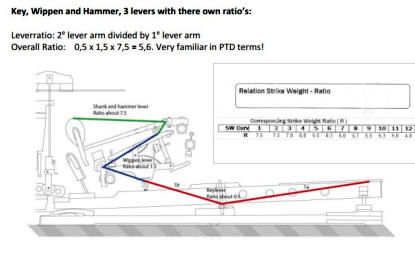



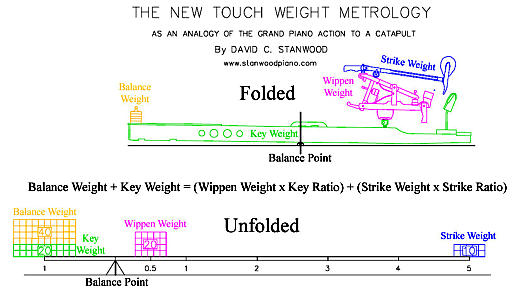


PIANOSERVICE
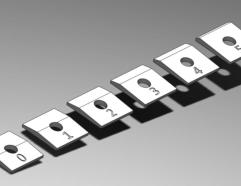
David
Stanwood
also
offers
SALA
.
The
S
tanwood
A
djustable
L
everage
A
ction
is
a
modification
under
the
keyboard
that
allows
you
to
manually
change
the
fulcrum
position
under
the
key
with
multiple
flexible
ratio/dynamic
enertion
choices.
SALA
and
the
MBA
are
different.
MBA,
the
MagneticBalanceAction
by
Hans
Venlo
only
changes
the
BW
by
adjusting
the
magnets
in
the
key.
SALA
changes
the
inertia
in
the
touch
by
changing the ratio.
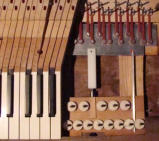
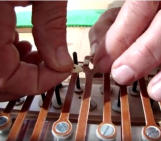
Join the ‘Precision Touch Design Platform’
OBW available at Jahn


Also
the
procedure
to
calibrate
the
88
keys
in
four
or
five
different DW sections is not very efficient to make an equal BW.
Indeed,
in
the
bass,
medium
and
discant
friction
differs,
hence
traditionally
this
different
DW
sections
but
the
actual
friction
per key is not mesured here.
And
also
the
recommendations
for
the
UW
which
are
only
specified
by
a
+limit
value
number
don’t
not
make
sense.
See
Steinway example here with UW specified +19 for all sections.
So this conservative procedure is clearly less precise.
It’s so logic to use BW for keyweight calculation.
Friction
does
not
affect
the
balance
weight
or
the
dynamic
touchweight
and
is
consequently
not
used
in
the
Stanwood
equation.
BW
is
the
constant
value
PTD
uses
as
reference
to
determine
the frontweight (FW).
01 05 2000 Danny Boddin
And
again
if
you
don't
analyse
and
adjust
the
hammerweights
primarily,
you’ll
never
get
an
equal
decreasing
inertia in dynamic touch.
You
could
assume
that
an
error
of
one
gram
more
or
less
in
a
hammer
is
negligible
when
balancing
the
touchweight,
but
with
e.g.
a
transmission
ratio
of
5.5
you
get
1
gr
x
5.5
=
5.5
grams
static
weight
difference.
Traditional
downweight
calibration
compensates
this
5,5
gr
weight
difference
with
the
amount
or
position
of
lead
in
the
frontpart
of
the key.
This
does
not
result
in
an
equal
decreasing
leadweight
pattern
and
creates
additional
irregularity
in
dynamic
touch
because
the
inertia
of
the
key
weight
also
contributes
+/-
10%
to
the
total
dynamic
touch
weight.
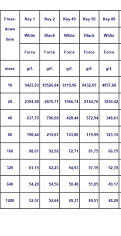

C40 with a BW + FW = ( WW x KR ) + ( SW x Ratio )
light hammer 8,6g : 37,96 + 26,8 = ( 16 x 0,5 ) + ( 8,6 x 6,6 )
correct SW/Ratio matches
heavier hammer 10,5g : 37,90 + 26,8 = ( 16 x 0,5 ) + ( 10,5 x 5,4 )
Imagine building pianos with a new standard for action calibration, reliably and predictably in dynamic touch-weight. I believe this will be the future for piano actions.
Over
the
years,
David
Stanwood
could
compare
numerous
PTD
analyses
and
also
compared them with pianists’ feedback.
With
this
information,
he
found
which
touch
plays
effortlessly
and
which
doesn’t
have
such a comfortable feel.
The
Stanwood
equation
enables
to
know
which
hammer
weight
and
ratio
can
be
combined
for
acceptable
dynamic
inertia
in
the touch.
The
PTDAE
has
been
practised
for
ten
years.
Over
500
Precision
Touch
Designs
have
been
installed in Europe.
From
work
with
PTD,
David
Stanwood
recently developted
SNAP
.
The
Stanwood
New
Action
Protocol
is
designed
for
use
in
factories.
It
is
specially
adapted to a standard for production.
With
SNAP
,
the
keys
are
first
calibrated
with
a
weight
pattern
for
high,
medium,
or
low
inertia.
Once
this
pattern
is
installed,
it
can
be
combined
with
any
curve
of
hammer
weight
(SW)
as
long
as
the
advised
SW/Ratio
is
respected.
here
is
an
example
of
a
medium
inertia
choice
for
key
C40.
Installed
with
two
different
hammer
weights
(8,6
and
10,5g)
,
the BW and FW
are identical.
The
correct
SW/Ratio
match
in
both
equations
results
in
the
same
inertia
comfort
in
the
touch.
If
your
choice
of
hammers
is
too
heavy
in
relation
to
the
existing
ratio,
you
wil
notice
your
BW
is
too
high.
The
solution
is
either
to
reduce
the
hammerweight
or
to
adjust
the
existing
ratio.
This
esures
the
correct
R/SW
match
and
desired
BW.
Obviously,
the
software
designed
by
the
PTDAE
gives you greater insight into these relationships.
For
this
adjustment
you
can
use
the
OBW
,
or
you
can
design
a
standard
for
capstan
and
wippen
heel
location,
and
for
wippen
heel
height.
With
their choice of movable heels, the WNG wippens are an ideal option here.


At
customers’
special
request,
your
designed
ratio/inertia
can
be
changed
quickly.
You
simply
replace
the
OBW
with
another
size,
but
dip
or
blow
need
to be adjusted.


Some
brands
began
recently
to
control
their
hammers
for
smoother
weight
decrease,
this
is
certainly
felt
in
better
evenness
of
touch.
Unfortunatily
in
production
the
importance
of
a
specific
transmission
ratio
on
a
specific
piano has not been taking in account yet.
And
the
need
to
apply
a
controled
dynamic
touch
has
not
been
stimulated
to
much
since
pianists
have
an
abbility
to
play
on
any
not
to
bad
piano
without
complaining
too much.
That’s
why
you
will
find
a
diversity
of
inertia
in
a range of pianos of the same brand.
This
is
one
of
the
main
reasons
why
they
feel
and
sound
different
and
not
always
for
the
best
because
their
diversity
is
not
designed
on
purpose
but
rather
comes
out
of
coincidence
without
awareness
of
the
impact
of
inertia/ratio relation.
Meanwhile
pianists
also
developed
an
expertise
to recognice an optimized touch.
and
I
always
notice
that
after
some
hours
of
practise on a PTD action they are surprised
when
discovering
the
new
subtil
possibilities
in
touch control.
Their
technique
transforms
and
they
experience
more
connection
with
the
sound
they produce and, they fall in love with it.
There
is
no
doubt
that
the
demand
for
PTD
and SNAP will grow.
I
wonder
which
companies
will
be
among
the
first
to
start
SNAP
in
production,
it
will
definitely change marketpositions and
I’m
curious
what
movement
of
sales
volume
this will generate.

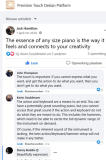


Today everybody can easely acces all
PTD information.
I specialy refer to the articles on Davids site and to Mario Igrecs excellent book ‘ Pianos Inside Out’ chapter 9
Recently
someone
associeted
PTD
with
the
term
'rocket
science'
despite
the
fact
that the Stanwood method only uses simple mathematics, see-saw science.
It
is
also
thought
installing
a
PTD
is
complicated
although
the
procedure
is
quite
simple and easy to learn.
PTD is much more work I hear, not profitable, time is money.
If
you
treat
individual
mechanics
it
is
indeed
labour
intensive
because
they
are
so
diverse.
Each
time
you
need
to
make
an
analysis
first
and
make
a
specific
design
to execute exactly yes this takes time.
But
if
you
integrate
SNAP
into
a
production
process
in
a
well
thought-out
way
it
will
work
out
faster
because
you
can
use
a
standard
version.
With
SNAP
you
design
the
key
calibration
only
once.
Performing
that
standard
works
faster
than
traditional
and with accurate results.
For
example,
you
don't
need
anymore
to
mesure
manually
over
and
over
again
the
lead
positions
for
each
key.
You
can
indicate
the
lead
locations
quite
fast
with
a
template
calculated
according
to
the
Stanwood
lead
pattern
which,
I
quote
US
Patent
#5585582
°1994,
create
a
smooth
linear
progression
of
key
front
in
weights,
providing
a
more
uniform
‘feel’
to
the
piano
keys
when played by a pianist.
A complete standard PTD design is also made only once in production.
Adjusting
SW
indeed
require
additional
time,
but
again
you
can
reduce
this
in
factory
by
applying
a
technical
standard
procedure.
With
PTD
you
probably
will
reach
the
same
total
time
efficiency.
For
example,
an
adjusted
SW
curve
usually
speeds up the final intonation this compensates for supplementary SW labour.
In
any
way,
the
huge
improvement
of
touch
quality
will
compensate
for
any
extra
work.
With
a
well-balanced
mechanism,
the
pianist
can
make
more
efficient
contact
with
the
sound
of
his
piano.
A
more
subtle
touch
creates
a
greater
musical
development
in
phrasing
and
interpretation.
This
SNAP
specific
concrete
playing
quality is at the end the valuable asset in sale and marketing.
Once again, we know how to analyse piano actions more thoroughly,
we know exactly how to improve them.
Let us apply this knowledge now and work together
on a high quality level for the the pianist, his music, his future.
C o n c l u s i o n
Inovations
usually
take
time
to
settle
in
society.
An
initial
conservative
reluctance
to
embrace
the
new
is
normal
and
relies
on
various
belief
structures usually based on a lack of information and practical knowhow.
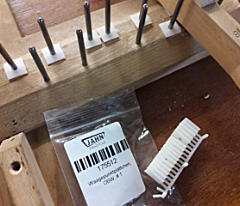

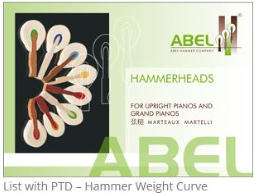
Up
to
now
in
factories
the
concept
BALANCE
WEIGHT
is
not
in
use
for
keyweight
calibration:
traditionally
the
amount
and
position
of
lead
in
the
front
of
the
key
is
determined
by
mesuring
the
downweight
(DW)
and
adjusting
it
to
around
50
gr
with
a
check for sufficiently upwight (UW).
The
idee
behind
this
procedure
is
getting
an
even
touch
but
regrettably
you will create exactly the opposite.
With
this
DW
procedure
the
effective
weight
of
the
front
key
(FW)
is
not
determined
and
as
a
consequence
the
balance
weight
remains
also
an
unknown parameter.
And
this
BW
is
precisely
the
value
you
can
consistently
use
to
determine
the dynamic touchweight.
Even
in
if
you
maintain
an
equal
progression
of
hammer
weight
with
this
DW
procedure
the
balance
weight
will
not
be
equal
because
the
down
weight
is
the
sum
of
the
Balance
weight
+
Friction
and
that
friction
is
not
explicitly
measured
per
key.
Note
also
the
friction
in
the
mechanism
fluctuates
with
the
ambient humidity changes.

The amount of force needed to move
this 5.5 gr increases exponentially
with the acceleration of the
hammer.
Here a practical example of DW, FW and BW elaborated with the Stanwood equitation.
BW + FW = (KR x WW) + (R x SW)
At the front of the key you mesure a 10 gr friction resistance being the total of frictions on the
balancepin, capstan, knuckle and axes.
(UW - DW) / 2 = Friction
The total weight to be balanced is 60 gr,
being the weight of the hammer (10 gr x ratio 5) + the wippen (20gr x ratio 0.5) = totaal 60 gr.
An ideal balance weight is 38 gr , so I adjust the weight of the key to 22 gr FW.
BW 38 gr + FW 22 gr = (KR 0.5 x WW 20 gr) + (R 5.0 x SW 10 gr)
60 gr = 10 gr + 50 gr
The downweight (DW) is now 38gr BW + 10 gr friction = 48 gr DW
for pianist and technicians
We all keep learning with your comments and questions,
thank you for your important participation.
Using
SNAP
in
production
you
will
begin
by
calibrating
the
keys,
choosing
between one of the available Stanwood weight patterns.
Next,
you
choose
the
hammer
weight
for
the
power
and
tone
you
want
for that piano model.
You
should
be
aware
that,
for
some
time,
Abel
is
manufacturing
hammerheads
with
weightspecifications.
Renovating
the
action
in
future
doesn’t
need
to
lead-weight
the
keys
again,
you
can
order
hammers
with
the same weight specifications as the originals.
Thank you for visiting my website !
More about
BALANCEWEIGHT (BW)
(UW+BW) / 2 = BW
DW (downweight) - Friction = BW
UW (upweight) + Friction = BW
BW = balance weight
FW= weight of the key at the front
WW = wippen weight
KR = key ratio (usually about 0.5)
SW = hammer with shank weight

Danny Boddin





PIANOSERVICE

Thank you for visiting !

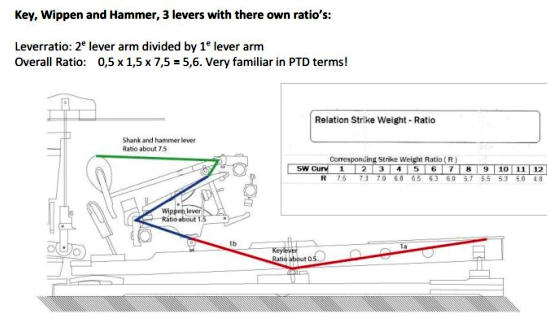
David
Stanwood
also
offers
SALA
.
The
S
tanwood
A
djustable
L
everage
A
ction
is
a
modification
under
the
keyboard
that
allows
you
to
manually
change
the
fulcrum
position
under
the
key
with
multiple
flexible
ratio/dynamic
enertion
choices.
SALA
and
the
MBA
are
different.
MBA,
the
MagneticBalanceAction
by
Hans
Venlo
only
changes
the
BW
by
adjusting
the
magnets
in
the
key.
SALA
changes
the
inertia
in
the
touch
by
changing the ratio.



Danny Boddin
Join the ‘Precision Touch Design Platform’




for pianists and technicians
We all keep learning with your comments and questions,
thank you for your important participation.



Imagine building pianos with a new standard for action calibration, reliably and predictably in dynamic touch-weight. I believe this will be the future for piano actions.
Over
the
years
David
Stanwood
could
compare
numerous
PTD
analyses and also compared them with pianists’ feedback.
With
this
information,
he
found
which
touch
plays
effortlessly
comfort
and which doesn’t have such a comfortable feel.
The
Stanwood
equation
enables
to
know
which
hammer
weight
and
ratio can be combined for acceptable dynamic inertia in the touch.
The
PTDAE
has
been
practised
for
ten
years.
Over
500
Precision
Touch
Designs have been installed in Europe.
Out of PTD David Stanwood developted recently his
SNAP
.
The
Stanwood
new
Action
Protocol
is
primarily
conceived
to
be
used in factory since it is adapted with a standard for production.
With
SNAP
the
keys
are
first
calibrated
with
a
weight
pattern
available for high, medium or low inertia.
Once
this
pattern
installed
it
can
be
combined
with
any
curve
of
hamerweight
(SW)
as
long
as
you
respect
the
advised
SW/Ratio
match.
here
is
an
example
of
a
medium
inertia
choice
for
key
C40.
Installed
with
two
different
hammer
weights
(8,6
and
10,5g)
,
the BW and FW
are identical.
The
correct
SW/Ratio
match
in
both
equations
results
in
the
same inertia comfort in the touch.
BW = balanceweight
FW= weight of the key at the front
WW = wippen weight
KR = key ratio (usually around 0.5)
SW = hammer with shank weight

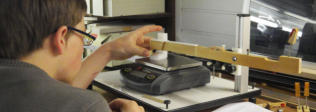
If
your
choice
of
hammers
is
too
heavy
in
relation
to
the
existing
ratio,
you
wil
notice
your
BW
is
too
high.
The
solution
is
either
to
reduce
the
hammerweight
or
to
adjust
the
existing
ratio.
This
esures
the
correct
R/SW
match
and
desired
BW.
Obviously,
the
software
designed
by
the
PTDAE
gives
you
greater
insight
into
these
relationships.
For
this
adjustment
you
can
use
the
OBW
,
or
you
can
design
a
standard
for
capstan
and
wippen
heel
location,
and
for
wippen
heel
height.
With
their
choice
of
movable
heels,
the
WNG
wippens
are
an
ideal option here.
Using
SNAP
in
production
you
will
begin
by
calibrating
the
keys,
choosing between one of the available Stanwood weight patterns.
Next,
you
choose
the
hammer
weight
for
the
power
and
tone
you
want for that piano model.
You
should
be
aware
that,
for
some
time,
Abel
is
manufacturing
hammerheads
with
weightspecifications.
Renovating
the
action
in
future
doesn’t
need
to
lead-weight
the
keys
again,
you
can
order
hammers with the same weight specifications as the originals.
At
customers’
special
request,
your
designed
ratio/inertia
can
be
changed
quickly.
You
simply
replace
the
OBW
with
another
size,
but
dip or blow need to be adjusted.
OBW available at Jahn





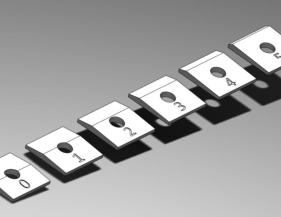

I
know
some
brands
started
recently
to
control
their
hammers
for
smoother
weight
decrease
and
this
is
certainly
felt
in
a
better
eveness of touch.
Unfortunatily
in
production
the
importance
of
a
specific
transmission
ratio
on
a
specific
piano
has
not
been
taking
in
account yet.
And
the
need
to
apply
a
controled
dynamic
touch
has
not
been
stimulated
to
much
since
pianists
have
an
abbility
to
play
on
any
not to bad piano without complaining too much.
That’s
why
you
will
find
a
diversity
of
inertia
in
a
range
of
pianos
of the same brand.
This
is
one
of
the
main
reasons
why
they
feel
and
sound
different
and
not
always
for
the
best
because
their
diversity
is
not
designed
on
purpose
but
rather
comes
out
of
coincidence
without
awareness of the impact of inertia/ratio relation.
Meanwhile
pianists
also
developed
an
expertise
to
recognice
an
optimized
touch
and
I
always
notice
that
after
some
hours
of
practise
on
a
PTD
action
they
are
surprised
when
discovering
the
new subtil possibilities in touch control.
Their
technique
transforms
and
they
experience
more
connection
with the sound they produce and, they fall in love with it.
There is no doubt that the demand for PTD and SNAP will grow.
I
wonder
which
companies
will
be
among
the
first
to
start
SNAP
in
production,
it
will
definitely
change
marketpositions
and
I’m
curious what movement of sales volume this will generate.
Today everybody can easely acces all PTD information.
I specialy refer to the articles on Davids site and to Mario Igrecs excellent book ‘ Pianos Inside Out’ chapter 9

Here a practical example of DW, FW and BW
elaborated with the Stanwood equitation.
BW + FW = (KR x WW) + (R x SW)
At the front of the key you mesure a
10 gr friction resistance being the total of frictions
on the balancepin, capstan, knuckle and axes.
(UW - DW) / 2 = Friction
The total weight to be balanced is 60 gr,
being the weight of the hammer (10 gr x ratio 5)
+ the wippen (20gr x ratio 0.5) = totaal 60 gr.
An ideal balance weight is 38 gr ,
so I adjust the weight of the key to 22 gr FW.
BW 38 gr + FW 22 gr = (KR 0.5 x WW 20 gr) + (R 5.0 x SW 10 g
60 gr = 10 gr + 50 gr
The downweight (DW) is now 38gr BW + 10 gr friction = 48 gr DW
More about
BALANCEWEIGHT (BW)
(UW+BW) / 2 = BW
DW (downweight) - Friction = BW
UW (upweight) + Friction = BW
Up
to
now
in
factories
the
concept
BALANCE
WEIGHT
is
not
in
use
for
keyweight
calibration:
traditionally
the
amount
and
position
of
lead
in
the
front
of
the
key
is
determined
by
mesuring
the
downweight
(DW)
and
adjusting
it
to
around
50
gr
with
a
check
for sufficiently upwight (UW).
The
idee
behind
this
procedure
is
getting
an
even
touch
but
regrettably you will create exactly the opposite.
With
this
DW
procedure
the
effective
weight
of
the
front
key
(FW)
is
not
determined
and
as
a
consequence
the
balance
weight
remains also an unknown parameter.
And
this
BW
is
precisely
the
value
you
can
consistently
use
to
determine the dynamic touchweight.
Even
in
if
you
maintain
an
equal
progression
of
hammer
weight
with
this
DW
procedure
the
balance
weight
will
not
be
equal
because
the
down
weight
is
the
sum
of
the
Balance
weight
+
Friction
and
that
friction
is
not
explicitly
measured
per
key.
Note
also
the
friction
in
the
mechanism
fluctuates
with
the
ambient
humidity changes.
Also
the
procedure
to
calibrate
the
88
keys
in
four
or
five
different
DW sections is not very efficient to make an equal BW.
Indeed,
in
the
bass,
medium
and
discant
friction
differs,
hence
traditionally
this
different
DW
sections
but
the
actual
friction
per
key is not mesured here.
And
also
the
recommendations
for
the
UW
which
are
only
specified by a +limit value number don’t not make sense.
See
Steinway
example
here
with
UW
specified
+19 for all sections.
So
this
conservative
procedure
is
clearly
less
precise.
It’s
so
logic
to
use
BW
for
keyweight
calculation.
Friction
does
not
affect
the
balance
weight
or
the
dynamic
touchweight
and
is
consequently
not
used
in
the
Stanwood
equation.
BW
is
the
constant
value
PTD
uses
as
reference
to
determine
the
frontweight (FW).

And
again
if
you
don't
analyse
and
adjust
the
hammerweights
primarily,
you’ll
never
get
an
equal
decreasing
inertia
in
dynamic
touch.
You
could
assume
that
an
error
of
one
gram
more
or
less
in
a
hammer
is
negligible
when
balancing
the
touchweight,
but
with
e.g.
a
transmission
ratio
of
5.5
you
get
1
gr
x
5.5
=
5.5
grams
static
weight difference.
The amount of force needed to move this 5.5 gr increases
exponentially with the acceleration of the hammer.
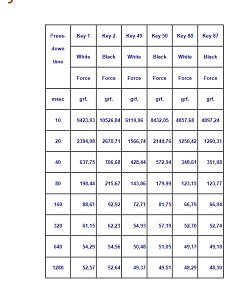


Traditional
downweight
calibration
compensates
this
5,5
gr
weight
difference
with
the
amount
or
position
of
lead
in
the
frontpart
of
the key.
This
does
not
result
in
an
equal
decreasing
leadweight
pattern
and
creates
additional
irregularity
in
dynamic
touch
because
the
inertia
of
the
key
weight
also
contributes
+/-
10%
to
the
total
dynamic
touch weight.
C o n c l u s i o n
Inovations
usually
take
time
to
settle
in
society.
An
initial
conservative
reluctance
to
embrace
the
new
is
normal
and
relies
on
various
belief
structures
usually
based
on
a
lack
of
information
and
practical knowhow.
Recently
someone
associeted
PTD
with
the
term
'rocket
science'
despite
the
fact
that
the
Stanwood
method
only
uses
simple
mathematics, see-saw science.
It
is
also
thought
installing
a
PTD
is
complicated
although
the
procedure is quite simple and easy to learn.
PTD is much more work I hear, not profitable, time is money.
If
you
treat
individual
mechanics
it
is
indeed
labour
intensive
because
they
are
so
diverse.
Each
time
you
need
to
make
an
analysis
first
and
make
a
specific
design
to
execute
exactly
yes
this
takes time.
But
if
you
integrate
PTD
into
a
production
process
in
a
well
thought-
out
way
it
will
work
out
faster
because
you
can
use
a
standard
version.
With
PTD
you
design
the
key
calibration
only
once.
Performing
that
standard
works
faster
than
traditional
and
with
accurate results.
For
example,
you
don't
need
anymore
to
mesure
manually
over
and
over
again
the
lead
positions
for
each
key.
You
can
indicate
the
lead
locations
quite
fast
with
a
template
calculated
according
to
the
Stanwood
lead
pattern
which,
I
quote
US
Patent
#5585582
°1994,
create
a
smooth
linear
progression
of
key
front
in
weights,
providing
a
more
uniform
‘feel’
to
the
piano
keys
when
played
by
a
pianist.
A
complete
standard
SNAP
design
is
also
made
only
once
in
production.
Adjusting
SW
indeed
require
additional
time,
but
again
you
can
reduce
this
in
factory
by
applying
a
technical
standard
procedure.
With
SNAP
you
probably
will
reach
the
same
total
time
efficiency.
For
example,
an
adjusted
SW
curve
usually
speeds
up
the
final
intonation this compensates for supplementary SW labour.
01 05 2000 Danny Boddin
C40 with a
BW + FW = ( WW x KR ) + ( SW x Ratio )
light hammer 8,6 gr :
37,96 + 26,8 = ( 16 x 0,5 ) + ( 8,6 x 6,6 )
correct SW/Ratio matches
heavier hammer 10,5 gr :
37,90 + 26,8 = ( 16 x 0,5 ) + ( 10,5 x 5,4 )
In
any
way,
the
huge
improvement
of
touch
quality
will
compensate
for
any
extra
work.
With
a
well-balanced
mechanism,
the
pianist
can
make
more
efficient
contact
with
the
sound
of
his
piano.
A
more
subtle
touch
creates
a
greater
musical
development
in
phrasing
and
interpretation.
This
SNAP
specific
concrete
playing
quality is at the end the valuable asset in sale and marketing.
Once again, we know how to analyse piano actions more
thoroughly,
we know exactly how to improve them.
Let us apply this knowledge now and work together
on a high quality level for the the pianist, his music, his
future.
+ 32 (0)475 43 38 43




PIANOSERVICE

PIANOSERVICE
Thank you for visiting !
Join the ‘Precision Touch Design Platform’




for pianists and technicians
We all keep learning with your comments and questions,
thank you for your important participation.


A VISION AND A MISSION FOR PIANO BUILDERS Imagine building pianos with a new standard for action calibration. reliably and predictably in dynamic touch weight. I believe this will be the future for piano actions.
Over
the
years,
David
Stanwood
could
compare
numerous
PTD
analyses
and
also
compared
them
with the pianists’ feedback.
With
this
information,
he
found
which
touch
plays
effortlessly
and
which
doesn’t
have
such
a
comfortable feel.
The
Stanwood
equation
enables
to
know
which
hammer
weight
and
ratio
can
be
combined
for
acceptable dynamic inertia in the touch.
The
PTDAE
has
been
practised
for
ten
years.
Over
500
Precision
Touch
Designs
have
been
installed
in
Europe.
David Stanwood developted recently his
SNAP
.
The
Stanwood
new
Action
Protocol
is
designed
for
use
in
factories.
It
is
specially
adapted
to
a
standard
for production.
With
SNAP,
the
keys
are
first
calibrated
with
a
weight
pattern for high, medium or low inertia.
Once
this
pattern
is
installed
it
can
be
combined
with
any
curve
of
hammer
weight
(SW)
as
long
as
the SW/Ratio is respected.
HERE
IS
an
example
of
a
medium
inertia
choice
for
key
C40.
Installed
with
two
different hammerweightS (8,6 and 10,5g)
BW and FW
are identical.
The
correct
SW/Ratio
match
in
both
equations
results
in
the
same
inertia
comfort
in
the
touch.
BW = balanceweight
FW= weight of the key at the front
WW = wippen weight
KR = key ratio (usually about 0.5)
SW = hammer with shank weight
C40 with a
BW + FW = ( WW x KR ) + ( SW x Ratio )
light hammer 8,6g :
37,96 + 26,8 = ( 16 x 0,5 ) + ( 8,6 x 6,6 )
correct SW/Ratio matches
heavier hammer 10,5g :
37,90 + 26,8 = ( 16 x 0,5 ) + ( 10,5 x 5,4 )


If
your
choice
of
hammers
is
too
heavy
in
relation
to
the
existing
ratio,
you
wil
notice
your
BW
is
too
high.
The
solution
is
either
to
reduce
the
hammerweight
or
to
adjust
the
existing
ratio.
This
esures
the
correct
R/SW
match
and
desired
BW.
Obviously,
the
software
designed
by
the
PTDAE
gives
you
greater
insight
into
these relationships.
For
this
adjustment
you
can
use
the
OBW
,
or
you
can
design
a
standard
for
capstan
and
wippen
heel
location,
and
for
wippen
heel
height.
With
their
choice
of
movable
heels,
the
WNG
wippens
are
an
ideal option here.
Using
SNAP
in
production
you
will
begin
by
calibrating
the
keys,
choosing
between
one
of
the
available Stanwood weight patterns.
Next,
you
choose
the
hammer
weight
for
the
power
and tone you want for that piano model.
You
should
be
aware
that,
for
some
time,
Abel
is
manufacturing
hammerheads
with
weightspecifications.
Renovating
the
action
in
future
doesn’t
need
to
lead-weight
the
keys
again,
you
can
order
hammers
with
the
same
weight
specifications
as the originals.
At
customers’
special
request,
your
designed
ratio/inertia
can
be
changed
quickly.
You
simply
replace
the
OBW
with
another
size,
but
dip
or
blow
need to be adjusted.
OBW available at Jahn
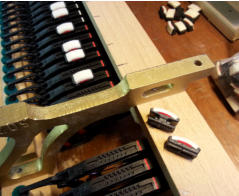

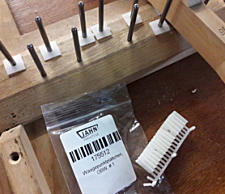


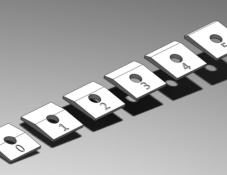

I
know
some
brands
started
recently
to
control
their
hammers
for
smoother
weight
decrease
and
this
is
certainly felt in a better eveness of touch.
Unfortunatily
in
production
the
importance
of
a
specific
transmission
ratio
on
a
specific
piano
has
not been taking in account yet.
And
the
need
to
apply
a
controled
dynamic
touch
has
not
been
stimulated
to
much
since
pianists
have
an
abbility
to
play
on
any
not
to
bad
piano
without complaining too much.
That’s
why
you
will
find
a
diversity
of
inertia
in
a
range of pianos of the same brand.
This
is
one
of
the
main
reasons
why
they
feel
and
sound
different
and
not
always
for
the
best
because
their
diversity
is
not
designed
on
purpose
but
rather
comes
out
of
coincidence
without
awareness
of
the
impact of inertia/ratio relation.
Meanwhile
pianists
also
developed
an
expertise
to
recognice
an
optimized
touch
and
I
always
notice
that
after
some
hours
of
practise
on
a
PTD
action
they
are
surprised
when
discovering
the
new
subtil
possibilities in touch control.
Their
technique
transforms
and
they
experience
more
connection
with
the
sound
they
produce
and,
they fall in love with it.
There
is
no
doubt
that
the
demand
for
PTD
and
SNAP will grow.
I
wonder
which
companies
will
be
among
the
first
to
start
SNAP
in
production,
it
will
definitely
change
marketpositions
and
I’m
curious
what
movement
of
sales volume this will generate.
Today everybody can easely acces all PTD information.
I specialy refer to the articles on Davids site and to Mario Igrecs excellent book ‘ Pianos Inside Out’ chapter 9

Here a practical example of DW, FW and BW
elaborated with the Stanwood equitation.
BW + FW = (KR x WW) + (R x SW)
At the front of the key you mesure a
10 gr friction resistance being the total of frictions
on the balancepin, capstan, knuckle and axes.
(UW - DW) / 2 = Friction
The total weight to be balanced is 60 gr,
being the weight of the hammer (10 gr x ratio 5)
+ the wippen (20gr x ratio 0.5) = totaal 60 gr.
An ideal balance weight is 38 gr ,
so I adjust the weight of the key to 22 gr FW.
BW 38 gr + FW 22 gr =
(KR 0.5 x WW 20 gr) + (R 5.0 x SW 10 g
60 gr = 10 gr + 50 gr
The downweight (DW) is now
38gr BW + 10 gr friction = 48 gr DW
More about
BALANCEWEIGHT (BW)
(UW+BW) / 2 = BW
DW (downweight) - Friction = BW
UW (upweight) + Friction = BW
Up
to
now
in
factories
the
concept
BALANCE
WEIGHT
is
not
in
use
for
keyweight
calibration:
traditionally
the
amount
and
position
of
lead
in
the
front
of
the
key
is
determined
by
mesuring
the
downweight
(DW)
and
adjusting
it
to
around
50 gr with a check for sufficiently upwight (UW).
The
idee
behind
this
procedure
is
getting
an
even
touch
but
regrettably
you
will
create
exactly
the
opposite.
With
this
DW
procedure
the
effective
weight
of
the
front
key
(FW)
is
not
determined
and
as
a
consequence
the
balance
weight
remains
also
an
unknown parameter.
And
this
BW
is
precisely
the
value
you
can
consistently
use
to
determine
the
dynamic
touchweight.
Even
in
if
you
maintain
an
equal
progression
of
hammer
weight
with
this
DW
procedure
the
balance
weight
will
not
be
equal
because
the
down
weight
is
the
sum
of
the
Balance
weight
+
Friction
and
that
friction
is
not
explicitly
measured
per
key.
Note
also
the
friction
in
the
mechanism
fluctuates
with
the
ambient humidity changes.
Also
the
procedure
to
calibrate
the
88
keys
in
four
or
five
different
DW
sections
is
not
very
efficient
to
make an equal BW.
Indeed,
in
the
bass,
medium
and
discant
friction
differs,
hence
traditionally
this
different
DW
sections
but the actual friction per key is not mesured here.
And
also
the
recommendations
for
the
UW
which
are
only
specified
by
a
+limit
value
number
don’t
not
make
sense.
See
Steinway
example
here
with
UW
specified
+19
for
all
sections.
So
this
conservative
procedure
is
clearly
less precise.
It’s so logic to use BW for keyweight calculation.
Friction
does
not
affect
the
balance
weight
or
the
dynamic
touchweight
and
is
consequently
not
used
in the Stanwood equation.
BW
is
the
constant
value
PTD
uses
as
reference
to
determine the frontweight (FW).

And
again
if
you
don't
analyse
and
adjust
the
hammerweights
primarily,
you’ll
never
get
an
equal
decreasing inertia in dynamic touch.
You
could
assume
that
an
error
of
one
gram
more
or
less
in
a
hammer
is
negligible
when
balancing
the
touchweight,
but
with
e.g.
a
transmission
ratio
of
5.5
you
get
1
gr
x
5.5
=
5.5
grams
static
weight
difference.
The amount of force needed to move this 5.5 gr
increases exponentially with the acceleration of the
hammer.



Traditional
downweight
calibration
compensates
this
5,5
gr
weight
difference
with
the
amount
or
position of lead in the frontpart of the key.
This
does
not
result
in
an
equal
decreasing
leadweight
pattern
and
creates
additional
irregularity
in
dynamic
touch
because
the
inertia
of
the
key
weight
also
contributes
+/-
10%
to
the
total
dynamic touch weight.
C o n c l u s i o n
Inovations
usually
take
time
to
settle
in
society.
An
initial
conservative
reluctance
to
embrace
the
new
is
normal
and
relies
on
various
belief
structures
usually
based
on
a
lack
of
information
and
practical
knowhow.
Recently
someone
associeted
PTD
with
the
term
'rocket
science'
despite
the
fact
that
the
Stanwood
method
only
uses
simple
mathematics,
see-saw
science.
It
is
also
thought
installing
a
PTD
is
complicated
although
the
procedure
is
quite
simple
and
easy
to
learn.
PTD
is
much
more
work
I
hear,
not
profitable,
time
is money.
If
you
treat
individual
mechanics
it
is
indeed
labour
intensive
because
they
are
so
diverse.
Each
time
you
need
to
make
an
analysis
first
and
make
a
specific
design
to
execute
exactly
yes
this
takes
time.
But
if
you
integrate
SNAP
into
a
production
process
in
a
well
thought-out
way
it
will
work
out
faster
because
you
can
use
a
standard
version.
With
SNAP
you
design
the
key
calibration
only
once.
Performing
that
standard
works
faster
than
traditional and with accurate results.
For
example,
you
don't
need
anymore
to
mesure
manually
over
and
over
again
the
lead
positions
for
each
key.
You
can
indicate
the
lead
locations
quite
fast
with
a
template
calculated
according
to
the
Stanwood
lead
pattern
which,
I
quote
US
Patent
#5585582
°1994,
create
a
smooth
linear
progression
of
key
front
in
weights,
providing
a
more
uniform
‘feel’
to
the
piano
keys
when
played
by a pianist.
A
complete
standard
SNAP
design
is
also
made
only once in production.
Adjusting
SW
indeed
require
additional
time,
but
again
you
can
reduce
this
in
factory
by
applying
a
technical
standard
procedure.
With
SNAP
you
probably
will
reach
the
same
total
time
efficiency.
For
example,
an
adjusted
SW
curve
usually
speeds
up
the
final
intonation
this
compensates
for
supplementary SW labour.
I
n
any
way,
the
huge
improvement
of
touch
quality
will
compensate
for
any
extra
work.
With
a
well-
balanced
mechanism,
the
pianist
can
make
more
efficient
contact
with
the
sound
of
his
piano.
A
more
subtle
touch
creates
a
greater
musical
development
in
phrasing
and
interpretation.
This
SNAP
specific
concrete
playing
quality
is
at
the
end
the valuable asset in sale and marketing.
Once again, we know how to analyse piano actions
more thoroughly,
we know exactly how to improve them.
Let us apply this knowledge now and work together
on a high quality level for the the pianist, his music,
his future.
01 05 2000 Danny Boddin
+ 32 (0)475 43 38 43


David
Stanwood
also
offers
SALA
.
The
S
tanwood
A
djustable
L
everage
A
ction
is
a
modification
under
the
keyboard
that
allows
you
to
manually
change
the
fulcrum
position
under
the
key
with
multiple
flexible
ratio/dynamic
enertion
choices.
SALA
and
the
MBA
are
different.
MBA,
the
MagneticBalanceAction
by
Hans
Venlo
only
changes
the
BW
by
adjusting
the
magnets
in
the
key.
SALA
changes
the
inertia
in
the
touch
by
changing the ratio.



Danny Boddin

